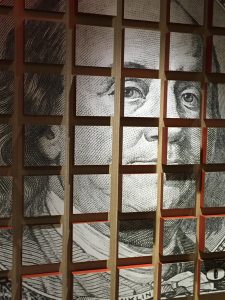July 25, 2016 • Musings
Quick: What’s the last purchase you made?
Odds are, it was today. And odds are it wasn’t with cash.
(My last purchase was with a credit card; I bought lunch for my team at a café. Before that, I put a few quarters in a parking meter.)

Avni M. Shah, an assistant marketing professor at the University of Toronto Scarborough, studies our association with cash as part of her research. Two recent studies, summarized in an article (“The Sting and Salve of Paying with Cash”) in the New York Times highlight her findings related to expenses—how we spend our money—and charity—how we support causes we love.
Not surprisingly, parting with cash “feels” more real to us than parting with money via a less tangible form of payment (like a credit card). That is one of the reasons the “envelope method” is a favored financial planning strategy, especially for clients who struggle to adhere to a self-imposed budget.
Using the envelope method, we manage our money entirely using envelopes full of cash. An envelope labeled “Clothing,” for example, may contain $100 for the month (if that is the amount you budget to spend on clothing). Once you’ve spent the allotted amount, additional purchases necessarily must come from another envelope. The envelopes that are more discretionary—those that purchase items that are more flexible—naturally fund any excesses. It’s easier to postpone a purchase of coffee, for example, than it is to postpone a payment to the utility company.
The envelope method worked better when our landlords, utility companies, and grocery vendors accepted cash payments with more frequency (or at all). Given our reliance on non-cash payment methods (credit cards, anyone?), using the envelope method exclusively seems silly.
As a realistic compromise, some financial planning systems (Mvelopes, for example) are built around the idea of the “envelope method,” as updated for our digital reality. Pictures of envelopes online show the amount of bills remaining in each category, and we manually move pictures of bills from one envelope to another based on our budget and spending activity.
An alternative option might be to limit your use of cash to discretionary purchases for a fixed period of time, say one month. By paying for groceries using only cash for a one-month period, you’ll naturally train your brain to see what a particular amount of groceries (say, $45) “looks like.” You’ll be better able to connect spending of a particular amount with the physical items in your cart.
None of these ideas are perfect. Using the envelope method means you lose out on tracking conveniences of digital purchase, plus potential benefits, like cash back options. Using a digital tool like Mvelopes approximates the physical movement of cash, but there is no real substitute for touching—and parting with—cash. Using cash for discretionary purchases can help train our brains, but without an all-or-nothing approach, it’s pretty easy to rationalize non-cash expenditures (which sort of defeats the whole purpose of re-training our brains).
However, there is a more compelling reason to prioritize cash: Mindfulness.
Dr. Shah touches on this in her research, and I’m excited to see where she’ll take this next. In considering donations subjects made to charities of their choice, the group that made cash contributions (instead of vouchers), “felt more of an emotional connection to the cause.”
By physically parting with our money, and intentionally choosing to make a purchase or support a cause we deem worthy, we align our values with our actions in a mindful way. And that level of mindfulness is definitely good for our own financial health.
Now What?
Looking to learn more? You may enjoy Chapter 9 of Arts & Numbers or the Budgeting Basics class from Minerva’s Starting SMART series.


